
Our power grid is experiencing a major transformation. With more energy from renewable sources being introduced to the grid, increasing power demand, and the greater power demand resulting from climatic weather conditions, the challenges and opportunities facing utilities are daunting. In addition, the need for more and newer types of data reflects the advent of renewables and co-gens, consumer-based generation has changed the grid to a two-way street. This morning’s consumer may be a power provider this afternoon.
At the turn of the 20th century, the power grid was designed for residential and industrial users and coal and gas-fired power producers located in a few places. As computers became a workplace staple, simple two-way data flow and communication were added as power demands grew.
Now, with the growing use of renewable energies from home rooftop solar panels and wind turbines, the delineation between user and producer is not as clear. This dramatic change in what today’s power grid looks and acts like has increased pressures on grid operators to adapt and adjust in real time. These adjustments have to be made at the edge—wherever power is generated—using real-time data, forcing utilities to think differently about how they operate and the technologies available to meet the rapidly evolving needs and expectations.
Rugged hardware is the foundation for the future of the electric power grid
Picture an electrical substation. Think about where it’s located, a remote area with limited or no commercial infrastructure. No on-site staff, just computers and switches—some of which are old-school levers. Exposed to extreme weather and environmental variables. It is a considerably much less forgiving setting than a clean, temperature-controlled data centers in the company’s urban offices. Taking high performance computing into tough, often unpredictable, environments require much more than a basic, off-the-shelf laptop. To deliver seamless operations in remote substations, the compute solution must:
- Meet strict IEEE, IEC and new, emerging standards
- Deliver ultra-high reliability and predictable performance
- Be easy to transport and deploy in remote locations
- Have a long operational life
To modernize the grid, the individual computers, controllers, and monitoring devices are being consolidated into smaller packages. These virtual machines use software running on special servers to share the workload, optimize use of the hardware, and significantly reduce the costs of not only the initial investment, but ongoing maintenance. By building this virtualized, centrally managed system, we will fundamentally change the landscape of the industry to meet the challenges of today and the future.
The value of virtualization
Virtualized systems provide remote control, increased reliability and increased security while reducing operational costs. With changes to the way a substation operates, both utility providers and power consumers can reap significant benefits, such as:
- Consolidating multiple workloads from various pieces of equipment down to a few servers
- Reducing physical hardware needs, initial purchase investments, and ongoing maintenance costs
- Running formerly separate applications simultaneously on a common server
- Increasing uptime through hyperconverged infrastructure clustering that consolidates software-defined computing, storage, and networking into one cluster
- Automatically migrating virtual machines of a failed server to other servers without disruption
- Providing integrated cybersecurity protections
Using rugged, high-performance compute solutions designed and tested to meet strict IEC61850-3 and IEE1613 requirements, will modernize the power grid to accommodate increased capacity, broader functionality, physical and cyber protections, and seamless reliability to keep power flowing smoothly.
Want more information? Click here.